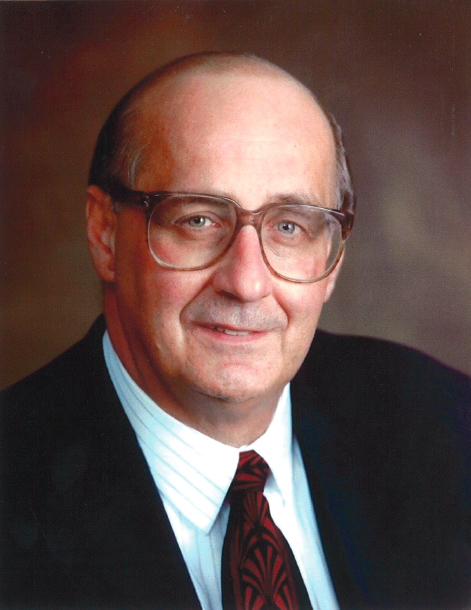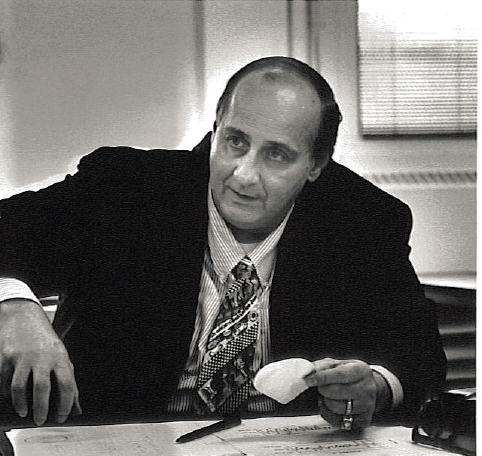

RICHARD E. DEVOR
1944–2011
Elected in 2000
“For contributions to the field of manufacturing research and its applications.”
BY JOHN W. SUTHERLAND AND SHIV G. KAPOOR
SUBMITTED BY THE NAE HOME SECRETARY
RICHARD EARL DEVOR, a manufacturing thought leader, innovative researcher, motivational teacher, inspirational mentor to hundreds of students and colleagues, and distinguished scholar and faculty member in the Department of Mechanical Science and Engineering at the University of Illinois at Urbana-Champaign (UIUC), passed away July 26, 2011, at his home in Lake Mills, Wisconsin. He was 67.
Dick was born in Milwaukee on April 18, 1944, to Robert and Betty (née Hale) DeVor. The family relocated to Lake Mills in the 1950s when Dick’s father established the DeVor Tool and Die company. Dick graduated in 1962 from Lake Mills High School, where he was a multisport athlete and outstanding student, and attended the University of Wisconsin–Madison, where he received his BS, MS, and PhD degrees in mechanical engineering in 1967, 1968, and 1971. As a graduate student, he was mentored by Shien-Ming (“Sam”) Wu.
After his father died in 1971 Dick became president of DeVor Tool & Die, a position he held until his passing. Over the years he grew the company to support the livelihoods of 20 employees and serve as an economic pillar of the Lake Mills community.
Also in 1971 he accepted a position as an assistant professor in the Department of Mechanical and Industrial Engineering
(M&IE) at UIUC and spent the remainder of his academic career there. He undertook many research investigations sponsored by government agencies and industry, and authored hundreds of papers.
Initially, his research focused on applying statistical methods to manufacturing (e.g., experimental design and time series). Over time he made substantial contributions to quality engineering, mechanistic modeling of machining systems, and micromanufacturing. He was named the Grayce Wicall Gauthier Professor in 1995 and the College of Engineering Distinguished Professor of Manufacturing in 2000 (emeritus in 2001).
In the classroom Dick was an inspirational and award-winning teacher. He taught courses on statistical design of experiments and industrial quality control and, on occasion, other classes related to manufacturing. Students thoroughly enjoyed his engaging and dynamic lectures—a mix of theory, trivia, jokes, practical insights, and professional wisdom. He often met with students outside the classroom to help them with difficult topics and to provide one-on-one counsel. As a graduate advisor, he mentored more than 150 MS, PhD, and postdoctoral students.
He held students to a high standard and expected them to meet it. Setting daunting goals, he inspired his students to rise to the challenges put before them. Students knew that failure was not an option. He was steadfast in his quest for excellence; the writing of a paper could go through uncountable drafts before it passed muster. Dick’s personal drive for high quality was passed on to nearly all his students. While he was a tough task master, he cared deeply about his students and was a fierce advocate for them. He continued to advise his students on nearly every aspect of their lives even after graduation.
His mentoring was not limited to his students. Industrial practitioners and faculty were often the recipients of his guidance and effective communication of his work ethic. He was not shy about sharing “uncomfortable truths” with colleagues, who ultimately benefited from his frank observations.
Dick was also a principal player in the quality renaissance in US manufacturing that occurred in the 1980s. Aided by
associates such as Tsong-how Chang and Don Ermer and supported by many of his graduate students, he developed and began teaching a series of industry short courses on statistical methods for quality and productivity improvement. Hundreds of these workshops were delivered to OEMs and their suppliers across the country, giving thousands of manufacturing professionals the opportunity to learn about statistical process control and design of experiments from a gifted teacher.
In addition to lectures and discussions, the industry courses incorporated computer games and software tools that enabled participants to make control charts or construct designed experiments and then use them to study and improve a computer-simulated manufacturing process. When quality pioneer W. Edwards Deming saw the students feverishly working during one of the game sessions, he complimented Dick on the ingenuity of the games and expressed his thrill to see the students’ enthusiasm. The instructional materials used for these short courses led to the development of a popular textbook, Statistical Quality Design and Control: Contemporary Concepts and Methods (Prentice Hall, 1992).
It was in the late 1970s that Dick began the research for which he is best known, mechanistic modeling of machining systems. He worked with one of the authors (SGK) as well as numerous students to create computer simulation models for various machining operations. These models were based on “first principles” and could predict the performance of such processes as end milling, face milling, and cylinder boring. This early work to “cut with the computer” did much to advance the cost-effectiveness of designing products and processes by avoiding the widely used “cut and try” approach. It also laid the groundwork for such current ideas as the digital twin and digital manufacturing.
In the mechanistic modeling paradigm, the geometry and structural properties of the part to be machined are input to the computer; other inputs include the tooling geometry, material characteristics, machine tool character, and process geometry. The computer-based mechanistic model enables a product or process designer to simulate the cutting of the
part, and the designer can modify a variety of parameters to identify how to best process the part. For example, different process geometries and operating conditions can be explored to find settings that are suitable in terms of forces, surface finish, power limitations, and part/machine tool deflection/vibration. Using computer simulations, a manufacturer could also identify the most effective way to fixture a part and guide the development of online process monitoring schemes for fault diagnosis.
In the early 1990s these mechanistic models were made available via the internet, to create virtual machining testbeds. Through Dick’s leadership, internet-based hardware testbeds were also established to remotely monitor and control machining systems. These seminal contributions paved the way for the Industrial Internet of Things, data analytics, and smart manufacturing.
From the early 1980s on, many companies worked with Professor DeVor on mechanistic machining model applications. These collaborations resulted in better processing strategies for new engine block concepts, gear broaching, and better machine tool structures. Insights were also provided to corporate partners on threading operations and drill geometry.
Dick’s research helped to lay the foundation for the field of mechanistic modeling and simulation of machining processes, and machine tool design and automation. His pioneering contributions also advanced understanding of cutting fluid filtration and helped to establish the nascent field of micromanufacturing in the early 2000s.
Over and above his teaching, research, scholarship, and mentoring, Dick actively served his university and the professional community. At UIUC, in addition to his professorial duties, he was associate head for graduate programs of the M&IE Department (1987–91) and director of the Institute for Competitive Manufacturing (1989–96 and 1999–2000).
He served the Society of Manufacturing Engineers (SME) as a member of the scientific committee of its North American Manufacturing Research Institution (NAMRI; 1982–98) and as president of NAMRI/SME in 1992. He helped organize the
1988 North American Manufacturing Research Conference, held at UIUC. He was also active on behalf of the NSF/DARPA Machine Tool–Agile Manufacturing Research Institute (MT-AMRI), International Conference on Micro-Manufacturing (ICOMM), and International Institution for Micro-Manufacturing (I2M2).
Dick was amazing to watch in these service activities. Through his dogged persistence and sheer force of personality he not only accomplished a great deal himself but also was extremely effective at motivating others to “get the job done.” At UIUC Dick was recognized more than 10 times for his teaching excellence by the Daily Illini (the campus newspaper). Department alumni bestowed on him the Two-Year Effective Teacher Award four times, and the Five-Year Effective Teacher Award three times. He was further honored with the College of Engineering Everitt Award for Teaching Excellence (1985), UIUC Campus Award for Excellence in Undergraduate Teaching (1987), and College of Engineering Halliburton Engineering Education Leadership Award (1989). He was recognized at the national level with the 1993 SME Education Award.
For his contributions to the manufacturing research literature, he was honored three times (1983, 1997, and 2008) with the ASME Blackall Machine Tool and Gage Award. He also received the ASME William T. Ennor Manufacturing Technology Award (2003) and NAMRI/SME S.M. Wu Research Implementation Award (2010). He was elevated to the rank of SME fellow in 1993 and ASME fellow in 1996. He was elected to the NAE in 2000 and in 2007 named an honorary member of ASME.
Richard DeVor contributed his leadership and enormous force of personality to every pursuit in which he was involved. His legacy and long-term impact can be characterized via several different measures based on those pursuits.
Through his research related to mechanistic modeling of machining systems, the science and practice of manufacturing have been significantly advanced, and the competitiveness of numerous industrial partners has been substantially
improved. He authored over 300 papers that appeared in journals and conference proceedings, and research scholars will build on these works for decades to come. Thousands of students at the university and in companies across the country benefited from his knowledge, wisdom, and clarity of communication. His teaching and scholarship related to statistical quality design and control contributed to the US manufacturing renaissance in the 1980s.
But if you were to ask Dick what he felt his legacy was, the answer would likely be his students. Through his guidance and motivation, they learned that they could achieve far more than they thought possible.
Those who knew Richard DeVor in the classroom, as a research advisor, or as a colleague or business associate dramatically benefited from his vision, wisdom, practical insights, commitment to excellence, and an incredible capacity for working hard. His dynamic personality, passion for manufacturing, enjoyment of a stimulating conversation, and genuine personal interest will be the things we remember most about him. He will continue to be a source of inspiration for all.
His wife of 43 years, Jearnice (née Luedtke), died May 18, 2011.








